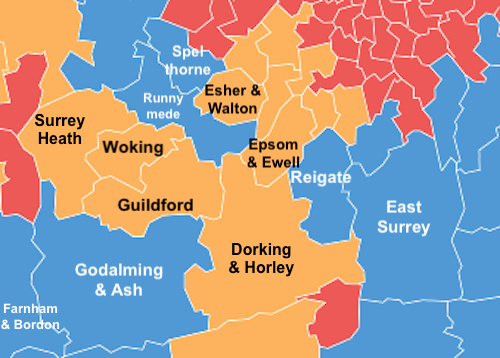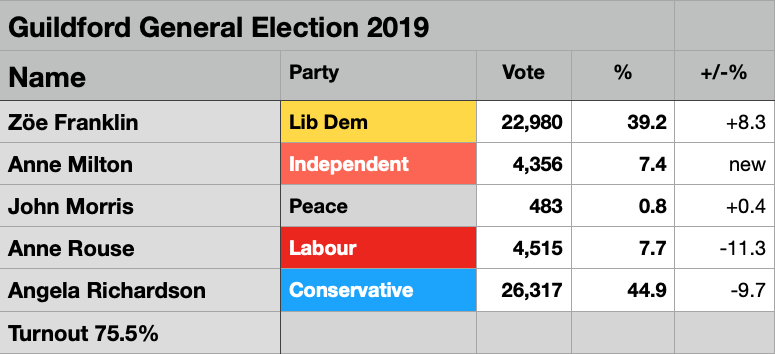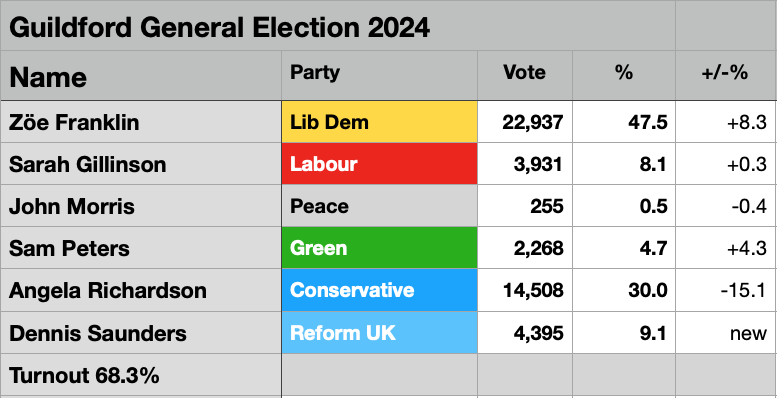 Abraham Lincoln
If given the truth, the people can be depended upon to meet any national crisis...
Abraham Lincoln
If given the truth, the people can be depended upon to meet any national crisis...
 Guildford news...
for Guildford people, brought to you by Guildford reporters - Guildford's own news service
Guildford news...
for Guildford people, brought to you by Guildford reporters - Guildford's own news service
Opinion: No One Can Control a Tide – But How Will the Waves Affect Guildford?
Published on: 8 Jul, 2024
Updated on: 8 Jul, 2024
By Martin Giles
Less than 50 miles south of Guildford, King Canute famously demonstrated the limit of his power by showing that even a powerful king could not command nature and turn the tide back.
On July 4, just over 1,000 years later, Conservative MPs all over the country demonstrated the same thing. The political tide had turned against them and helpless, apart from a hundred or so on slightly higher Conservative ground, they went under, including Guildford’s Angela Richardson.
It was hardly surprising. Polls had shown that widespread disaffection with the Tories commenced when the revelations and associated lying about lock-down parties at No 10 became known.
Since then there was a litany of errors, not least the disastrous 49-day premiership of Liz Truss.
Probably no leader could have reversed the Conservatives’ fortunes after that debacle but if any voters were still dithering, Rishi Sunak’s decision to leave the D-Day commemoration early probably decided them.
It sealed an own-goal hat-trick setting up a pivotal win for Labour nationwide and unprecedented gains for the Lib Dems in Surrey, including here in Guildford.
So let’s look at the Guildford result in a little more detail.
In 2019, six months after the dramatic defeat of the Conservatives in the borough council election, Guildford gave victory once again to the Tory parliamentary candidate but with a much-reduced majority.
There was, as usual, a mixture of motivations. Against the Tories there was for some a residual bitterness about Brexit and a sense of grievance about the way Anne Milton had been treated while those in the villages may have been influenced by the widely-hated Local Plan.
But in the Conservatives’ favour was a distrust of the direction the left-wing Labour leader Jeremy Corbyn might take the country and a widespread desire to see the politically-paralysing Brexit dithering end.
So Angela Richardson, who had been quickly selected by local Conservatives following Milton’s effective deselection, won, albeit with a reduced majority of 3,300.
If we compare this with last week’s result one thing stands out. It was not that the Liberal Democrat vote increased on Thursday, it was almost identical to the 2019 figure (albeit a larger percentage of a reduced turnout).
What happened was the Conservative vote collapsed in line with the national trend. It was down by nearly 12,000, from over 26,300 to just 14,500. Conservative voters, it seems, either stayed at home or switched to Reform UK which, from nowhere, came third, beating Labour into fourth place.
At the count, members of the Labour team acknowledged that they had, once again, suffered from tactical voting. Labour voters wishing to punish the Tories voted Lib Dem. Included in the paperstorm of Lib Dem leaflets sent out (our house received at least eight – against just two from the Conservatives) was even an on-the-record quote from a Labour supporter declaring her intention to vote tactically.
How many did that? We will never know precisely but in 2017, Labour’s Howard Smith, now a borough councillor, attracted over 10,500 votes while the Lib Dems got less than 3,000 more. It might be a clue.
The Guildford result was only one of six in Surrey’s normally true-blue political landscape that showed the dramatic impact of disillusion with the former Conservative Government.
The Lib Dems had smashed through the Tory “blue wall” making gains in areas that had been solidly Conservative for the last century or more.

The Lib Dems (shown in orange) have smashed through the Conservative “blue wall” in Surrey. Six Surrey constituencies are now Lib Dem.
It was undoubtedly dramatic, even historic, but what will they mean for the residents of Surrey, of Guildford?
The Lib Dems now have 72 of the 650 parliamentary seats. Its their best result for a century as Liberals and ever since they amalgamated with the SDP. But Labour has 412 seats. They don’t need to listen to anyone – certainly not Lib Dems from Surrey seats which are never likely to return Labour MPs.
As I write, Rachel Reeves, the new Chancellor, is announcing that top down housing targets will be instigated again. In their campaign, Labour said there are “grey” areas of green belt that could be used for housing development but their candidate in Guildford admitted she did not know of any in Guildford, which has already given up large areas of green belt under the Conservatives’ 2019 Local Plan.
Despite reluctant councils often being blamed, it has not been a recalcitrant GBC that has prevented development here but developers deciding when and how they will develop solely to maximise profit. Where the Lib Dems stand on Labour’s housing plans could be crucial if they are to maintain their current popularity.
Perhaps, at last, Guildford can build some much-needed council homes – some of the 3,000 so ridiculously promised by the Lib Dems in 2019.
Meanwhile most politicians, including the Lib Dems, keep their heads firmly in the sand about the levels of net migration, the primary factor driving the country’s unprecedented population increase and, ergo, demand for housing and strain on other infrastructure.
It has been a concern for many across the country. In other areas more affected than Guildford, Labour voters switched to Reform UK because of it. Why the previous government, despite its often repeated promises, allowed the numbers to grow out of control is a mystery and yet another electoral own-goal.
But Guildford’s new MP will, hopefully, have more luck with one of her often-stated priorities to tackle the problems of Thames Water’s poor management of our water supply and sewage. Surely Labour can agree urgent action is needed?
As for the Conservatives locally, the immediate future looks bleak for them. We can expect a period of quiet reflection while they choose a new leader. Nationally, the right-wing problem has re-emerged, thanks largely to the party’s record on immigration, but even here in Guildford, where the issue is lower profile, Reform UK had a respectable showing: more than 4,000 votes (9%).
Whether the Conservatives can heal the rift and, if so, how, is a major question and the fortunes of all the political parties are likely to be affected.
But we should not forget, just like the tide that King Canute showed he could not control, political fortunes ebb and flow. All governments are eventually brought down by events. Who is to say how the country will feel in five years’ time? After all, who in 2019 would have predicted a Labour landslide?
Responses to Opinion: No One Can Control a Tide – But How Will the Waves Affect Guildford?
Leave a Comment Cancel reply
Please see our comments policy. All comments are moderated and may take time to appear. Full names, or at least initial and surname, must be given.
Click on cartoon for Dragon story: Public Asked for Views on SCC’s Proposal for Reduced Speed Limits






Recent Articles
- Council Accepts Responsibility of Meeting Farnham Museum’s Ballooning Repair Costs
- Notice: Cut It Out!
- Stoke Park Was Bought 100 Years Ago with Plans for a Public Open Space and Houses!
- Dragon Review: The Pajama Game – Yvonne Arnaud Theatre
- A Hidden Gem in the Hills: Michelin-Backed William IV Pub Brings Refined Dining to Albury
- Letter: Help Reduce Speeding By Joining a Community Speedwatch Team
- Hospital Apologises ‘Unreservedly’ After Death of Disabled Girl
- Birdwatcher’s Diary No.328
- SCC Intends to Back Public Survey Result and Shorten Summer School Holidays
- A281 Expected to Remain Closed Until Repairs to Damaged Cottage Are Completed


Recent Comments
- Philip Camp on A Look Back at Perry Hill’s New Inn and a Family That Once Ran It
- RWL Davies on Community Councils Proposed to Maintain Local Representation
- Stephen Spark on Major Disruption on the Railway During Hot Day in 1900
- Jim Allen on Community Councils Proposed to Maintain Local Representation
- Jeremy Holt on Community Councils Proposed to Maintain Local Representation
- Lisa Land on Birdwatcher’s Diary No.328
Search in Site
Media Gallery
Dragon Interview: Local Artist Leaves Her Mark At One of England’s Most Historic Buildings
January 21, 2023 / No Comment / Read MoreDragon Interview: Lib Dem Planning Chair: ‘Current Policy Doesn’t Work for Local People’
January 19, 2023 / No Comment / Read MoreA3 Tunnel in Guildford ‘Necessary’ for New Homes, Says Guildford’s MP
January 10, 2023 / No Comment / Read More‘Madness’ for London Road Scheme to Go Ahead Against ‘Huge Opposition’, Says SCC Leader
January 6, 2023 / No Comment / Read MoreCouncillor’s Son Starts Campaign for More Consultation on North Street Plan
December 30, 2022 / No Comment / Read MoreCounty Council Climbs Down Over London Road Works – Further ‘Engagement’ Period Announced
December 14, 2022 / No Comment / Read MoreDragon Interview: GBC Reaction to the Government’s Expected Decision to Relax Housing Targets
December 7, 2022 / No Comment / Read MoreHow Can Our Town Centre Businesses Recover? Watch the Shop Front Debate
May 18, 2020 / No Comment / Read More









Mark Stamp
July 8, 2024 at 10:18 pm
I may not agree with Angela Richardson on many issues but I would like to appreciate the work she did as a local MP especially when many of her former colleagues spent their time on second jobs and I hope that is one thing at least that can be continued by our new local MPs.
Since the local elections in May, fewer than 20 per cent of the councillors across the borough and district councils in Surrey are now Conservative, I wonder what implications this will have for the county council which is up for election next year.
Olly Azad
July 9, 2024 at 12:52 pm
At least King Canute had the wisdom to realise that nature is a force to be reckoned with. If only the same thing could be said about the newly elected Prime Minister Sir Keir Starmer as he is now encouraging even more migrants to make the perilous journey trying to cross the English Channel when he states that the Rwanda policy is “dead and buried”.
Just as King Canute could not command the direction of the tide this new Labour government could find itself in choppy waters if net migration soon gets out if control.
Julian Lyon
July 9, 2024 at 11:29 pm
Interesting piece. Lib Dems actually got 43 votes fewer this time. Angela Richardson’s votes fragmented elsewhere or simply stayed at home – an 11,000 majority swing. Gosh politics can be cruel at an individual level!
Thanks Angela for your hard work. Best wishes and congratulations, Zoe.